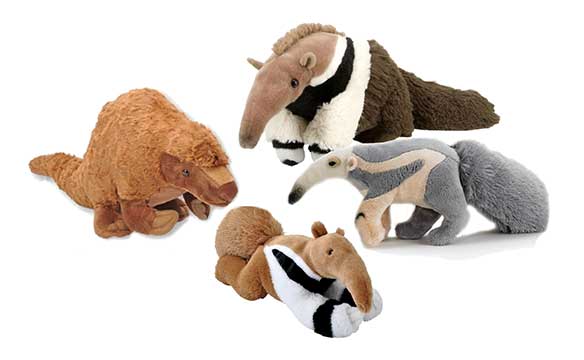

Anteater Plush Toys gifts and information.
You can find Anteater stuffed animals, plus facts and information about Anteaters in the Forest at Animals N More.
Here we have four anteater stuffed animals. From left we have the Pangolin, a kind of armored Anteater which is made by Wild Republic, then you see an Anteater Cuddlekins stuffed animal made by Wild Republic, then a big grey Anteater from Wildlife Artists. The little anteater at bottom is an Ecokins Mini Anteater made by Wild Republic. Check our sponsor's Gift Shop to see if we have any anteater stuffed animals in stock.
The Anteater is an insect-eating mammal found in Mexico, Central America, and South America. It has a long head with a long, tubular mouth and long tongue, but no teeth.
The giant anteater, weighing up to 86 lbs., is the largest species of anteater. It lives in forests and swampy areas and on open plains and is active mostly during the day in areas where there are few people, and is night dwelling in densely populated areas. The
coarse coat is gray, with a white-bordered black stripe on each shoulder, and the tail is long and bushy. The front claws, used to tear open termite mounds and for defense, are so long that they are tucked under, and the animal walks on its knuckles. The long sticky tongue flicks quickly in and out of the small mouth opening, scooping up termites or other insects.
The pygmy anteater is the smallest species of anteater, ranging from 13 to 20 inches. It is covered with golden-brown fur. Its jaws curve to form a short tube, and it eats termites and other insects. Living mainly in the trees, it has a prehensile tail (which means that the tail can be used as a hand in grasping branches.
The two species of lesser anteaters are the size of a large domestic cat and have short, coarse, tan to blackish hair, usually with a black band around body and neck. They also live in trees but frequently come down to the ground.
Both the pygmy and the lesser anteaters are mostly nocturnal and walk on the sides of their front feet because of the length of their claws. All three species are characterized by solitary habits and a low reproductive rate. The female carries the single young on her back during its growth; in the case of the giant anteater, this can last almost one year. Other, unrelated mammals called anteaters are the aardvark, echidna, pangolin, and numbat, or banded anteater, a marsupial.
Scientific classification: Anteaters make up the family Myrmecophagidae. The giant anteater is classified as Myrmecophaga tridactyla, the pygmy anteater as Cyclopes didactylus, and the lesser anteaters as Tamandua tetradactyla and Tamandua mexicana.



